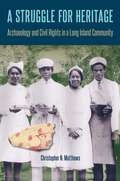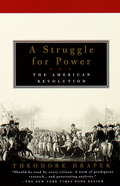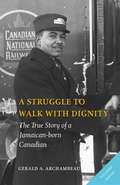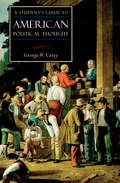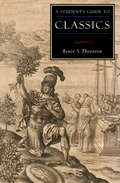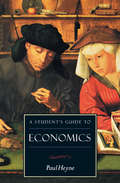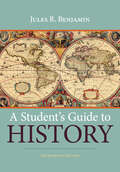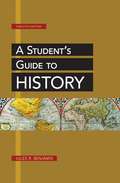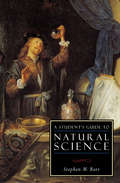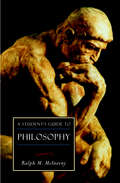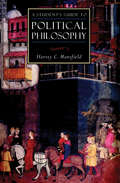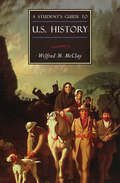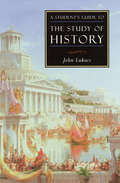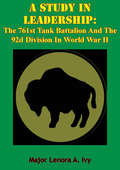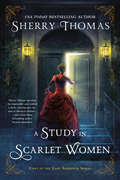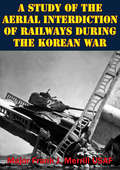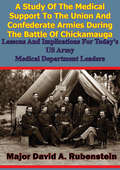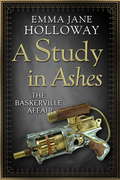- Table View
- List View
A Structuralist Theory of Economics (Routledge INEM Advances in Economic Methodology)
by Adolfo García de la SienraEconomists have long grappled with the problem of how economic theories relate to empirical evidence: how can abstract mathematized theories be used to produce empirical claims? How are such theories applied to economic phenomena? What does it mean to “test” economic theories? This book introduces, explains, and develops a structural philosophy of economics which addresses these questions and provides a unifying philosophical/logical basis for a general methodology of economics. The book begins by introducing a rigorous view of the logical foundations and structure of scientific theories based upon the work of Alfred Tarski, Patrick Suppes, Karl Marx, and others. Using and combining their methods, the book then goes on to reconstruct important economic theories – including utility theory, game theory, Marxian economics, Sraffian economic theory, and econometrics – proving all the main theorems and discussing the key claims and the empirical applicability of each theory. Through these discussions, this book presents, in a systematic fashion, a general philosophy of economics grounded in the structural view. Offering rigorous formulations of important economic theories, A Structuralist Theory of Economics will be invaluable to all readers interested in the logic, philosophy, and methodology of economics. It will also appeal particularly to those interested in economic theory.
A Struggle for Heritage: Archaeology and Civil Rights in a Long Island Community (Cultural Heritage Studies)
by Christopher N. MatthewsBased on ten years of collaborative, community-based research, this book examines race and racism in a mixed-heritage Native American and African American community on Long Island’s north shore. Through excavations of the Silas Tobias and Jacob and Hannah Hart houses in the village of Setauket, Christopher Matthews explores how the families who lived here struggled to survive and preserve their culture despite consistent efforts to marginalize and displace them over the course of more than 200 years. He discusses these forgotten people and the artifacts of their daily lives within the larger context of race, labor, and industrialization from the early nineteenth to the mid-twentieth century. A Struggle for Heritage draws on extensive archaeological, archival, and oral historical research and sets a remarkable standard for projects that engage a descendant community left out of the dominant narrative. Matthews demonstrates how archaeology can be an activist voice for a vulnerable population’s civil rights as he brings attention to the continuous, gradual, and effective economic assault on people of color living in a traditional neighborhood amid gentrification. Providing examples of multiple approaches to documenting hidden histories and silenced pasts, this study is a model for public and professional efforts to include and support the preservation of historic communities of color. A volume in the series Cultural Heritage Studies, edited by Paul A. ShackelPublication of the paperback edition made possible by a Sustaining the Humanities through the American Rescue Plan grant from the National Endowment for the Humanities.
A Struggle for Power
by Theodore Draperrom one of the great political journalists of our time comes a boldly argued reinterpretation of the central event in our collective past--a book that portrays the American Revolution not as a clash of ideologies but as a Machiavellian struggle for power.From the Trade Paperback edition.
A Struggle to Walk With Dignity: The True Story of a Jamaican-born Canadian
by Gerald A. ArchambeauGerald Augustus Archambeau was born in Jamaica in 1933. Raised in Kingston by his three aunts, he was sent to Canada in 1947 to join his mother and stepfather in Montreal. He trained in the plumbing and steam-fitting trade, but at age eighteen decided to join the railway as a passenger car porter. He worked for Canadian Pacific and Canadian National until the 1960s, when declining passenger rail traffic and the ascendence of air travel caused him to switch to a career with a major Canadian airline in Toronto. After his retirement from the airline, Gerald and his wife, Marion, settled in St. Catharines, Ontario.
A Student In Arms Vol. I (A Student in Arms #1)
by John St Loe Strachey Donald StracheyAfter Donald Hankey returned home from a posting with the Royal Garrison Artillery in Mauritius, following a serious bout of illness, it seemed as though he was destined for a career in the Church. Finding the clergy schools to be too stultifying, he set to work in missionary positions in the most impoverished communities in the east of London. As the First World War began to take its ominous toll of men, the first of Kitchener's recruiting calls was heard throughout the Empire; Hankey eschewed returning to the army as an officer and decided to enlist as a "gentleman ranker". However, his previous military experience marked him out and he was promoted, soon after which he would embark on his first tour of duty on the Western Front. Wounded at Ypres in a daylight infantry charge across no man's land, and having been published previously, he began to send articles to the Spectator from the front. He finally met his end on 12th October 1916 during the later phases of the battle of the Somme.John St Loe Strachey, the then editor of The Spectator, put together the articles along with unpublished papers to produce the two volume "A Student In Arms" as a tribute and memorial to Donald Hankey. Initially published in America to ensure that it passed censorship, it became a bestseller on both sides of the Atlantic in short order running to many editions (this text is taken from the 16th edition). The two volumes are often reflective in tone, between the jingoistic volumes produced at the beginning of the war and the despairing disillusioned books produced afterward. It is also clear the affinity that Hankey felt for the common soldier, and made no secret of the fact that he believed that the ranker who had so little to gain from sacrificing himself for the society at home put many of his supposed betters to shame.
A Student of History: A Novel
by Nina RevoyrA contemporary Los Angeles story of uncrossable social lines, allegiance and betrayal, immeasurable power, and the ways the present is continuously shaped by the past.“Revoyr is gifted in her ability to deal with complex ideas like racism, class conflict, and sexuality without sacrificing the truth of her narrative. Furthermore, like the most adroit novelists, Revoyr specializes in reversal. All of her books are filled with suspense and sudden surprises that take the stories in unexpected directions . . . As much as Nina Revoyr herself is a student of history, she’s also one of our best teachers.” —Los Angeles Review of Books “Revoyr’s latest noir tells a story that’s somewhere between Sunset Boulevard and the darker regions of The Great Gatsby . . . Revoyr is a subtle observer of human foibles and social structures, and the result is one of the most insightful, and the most entertaining books of the year.” —Literary Hub, one of Literary Hub’s 50 Favorite Books of 2019Rick Nagano is a graduate student in the history department at USC, struggling to make rent on his South Los Angeles apartment near the neighborhood where his family once lived. When he lands a job as a research assistant for the elderly Mrs. W—, the heir to an oil fortune, he sees it at first simply as a source of extra cash. But as he grows closer to the iconoclastic, charming, and feisty Mrs. W—, he gets drawn into a world of privilege and wealth far different from his racially mixed, blue-collar beginnings. Putting aside his half-finished dissertation, Rick sets up office in Mrs. W—’s grand Bel Air mansion and begins to transcribe her journals—which document an old Los Angeles not described in his history books. He also accompanies Mrs. W— to venues frequented by the descendants of the land and oil barons who built the city. One evening, at an event, he meets Fiona Morgan—the elegant scion of an old steel family—who takes an interest in his studies. Irresistibly drawn to Fiona, he agrees to help her with a project of questionable merit in the hopes he’ll win her favor.A Student of History explores both the beginnings of Los Angeles and the present-day dynamics of race and class. It offers a window into the usually hidden world of high society, and the influence of historic families on current events. Like Great Expectations and The Great Gatsby, it features, in Rick Nagano, a young man of modest means who is navigating a world where he doesn’t belong.
A Student's Commentary on Ovid's Metamorphoses Book 10
by Shawn O'BryhimDiscover a holistic perspective on Ovid’s Metamorphoses Book 10 with this insightful resource. In A Student’s Commentary on Ovid’s Metamorphoses Book 10, Shawn O’Bryhim offers an insightful and concise examination of the literary, grammatical, and textual matters integral to Book 10 of Ovid’s Metamorphoses. Expanding the scope of more traditional textbooks on Book 10, the author explores the archaeological, religious, and cultural elements of the work as it relates to Greece, Rome, and the Near East. Readers will benefit from the inclusion of: A multidisciplinary approach that examines the religious, archaeological, and cultural background of Ovid’s myths A Near Eastern perspective on the material, which will allow a deeper understanding of the subject matter An exploration of the grammatical and literary components that characterize Book 10 Intended primarily for undergraduates in advanced Latin courses on Ovid, A Student’s Commentary on Ovid’s Metamorphoses Book 10 will also earn a place in the library of anyone who desires a broader approach to the study of Book 10 of the Metamorphoses.
A Student's Guide to American Political Thought (ISI Guides to the Major Disciplines)
by George W. CareyA concise overview of the competing political philosophies that have shaped United States history. Who are the most influential thinkers, and which are the most important concepts, events, and documents in the study of the American political tradition? How ought we regard the beliefs and motivations of the founders, the debate over the ratification of the Constitution, the historical circumstances of the Declaration of Independence, the rise of the modern presidency, and the advent of judicial supremacy? These are a few of the fascinating questions canvassed by George W. Carey in A Student&’s Guide to American Political Thought. Carey&’s primer instructs students on the fundamental matters of American political theory while telling them where to turn to obtain a better grasp on the ideas that have shaped the American political heritage.
A Student's Guide to Classics (ISI Guides to the Major Disciplines)
by Bruce S. ThorntonBruce Thornton's crisp and informative Student's Guide to Classics provides readers with an overview of each of the major poets, dramatists, philosophers, and historians of ancient Greece and Rome. Including short bios of major figures and a list of suggested readings, Thornton's guide is unparalleled as a brief introduction to the literature of the classical world.
A Student's Guide to Economics (ISI Guides to the Major Disciplines)
by Paul HeyneWhat makes economies work—or not work? This concise overview of the field&’s great thinkers offers a wealth of information. Paul Heyne, one of the nation&’s best-selling economists, provides an accessible overview of the discipline of economics. Economic knowledge, he contends, is not complete without reference to the totality of human society—a realization essential to a proper understanding of the fundamental principles of economics. The sweep of economic thinking is presented here with reference to the great economists and important schools of thought.
A Student's Guide to History
by Jules BenjaminThis guide provides comprehensive coverage of the historians research process — from formulating a research question to how to find, evaluate, and work with sources of all types — written and nonwritten, in print and online. The writing process is explained thoroughly as advice on creating a strong thesis and writing an effective paper culminates with a model student research paper. The appendixes point students to the most helpful research resources.
A Student's Guide to History
by Jules R. BenjaminThis guide provides comprehensive coverage of the historian's research process from formulating a research question to how to find, evaluate, and work with sources of all types written and nonwritten, in print and online. The writing process is explained thoroughly as advice on creating a strong thesis and writing an effective paper culminates with a model student research paper.
A Student's Guide to History (4th Edition)
by Jules R. BenjaminThis compact, best-selling introduction to the study of history equips students with all the skills they need to succeed in a history course. A thoroughly class-tested guide through eight editions, the ninth edition provides students with even more practical tools and features -- including new, hands-on exercises -- that reinforce basic skills and explain tricky issues, saving instructors valuable classroom time.
A Student's Guide to Music History (ISI Guides to the Major Disciplines)
by R.J. Stove&“Delightfully sophisticated . . . the only music history that can be savored, muscatel in hand, in the green shade of a beach umbrella&” (John Simon, The Hudson Review). R. J. Stove&’s A Student&’s Guide to Music History is a concise account, written for the intelligent lay reader, of classical music&’s development from the early Middle Ages onwards. Beginning with a discussion of Hildegard von Bingen, a twelfth-century German nun and composer, and the origins of plainchant, Stove&’s narrative recounts the rise (and ever-increasing complexity) of harmony during the medieval world, the differences between secular and sacred music, the glories of the contrapuntal style, and the origins of opera. Stove then relates the achievements of the high baroque period, the very different idioms that prevailed during the late eighteenth century, and the emergence of Romanticism, with its emphasis upon the artist-hero. With the late nineteenth century came a growing emphasis on musical patriotism, writes Stove, especially in Spain, Hungary, Russia, Bohemia, Norway, Denmark, Finland, and the United States. A final section discusses the trends that have characterized music since 1945. Stove&’s guide also singles out eminent composers for special coverage, including Palestrina, Monteverdi, Handel, Bach, Haydn, Mozart, Beethoven, Schubert, Wagner, Verdi, Brahms, Debussy, Richard Strauss, Sibelius, and Messiaen. As a brief orientation to the history and contours of classical music, A Student&’s Guide to Music History is an unparalleled resource.
A Student's Guide to Natural Science (ISI Guides to the Major Disciplines #8)
by Stephen M. BarrA concise introduction to scientific history and ideas, with a special emphasis on physics and astronomy. Physicist Stephen M. Barr&’s lucid Student&’s Guide to Natural Science aims to give students an understanding, in broad outline, of the nature, history, and great ideas of natural science from ancient times to the present, with a primary focus on physics. Barr begins with the contributions of the ancient Greeks, in particular the two great ideas that reality can be understood by the systematic use of reason and that phenomena have natural explanations. He goes on to discuss, among other things, the medieval roots of the scientific revolution of the seventeenth century, the role played by religion in fostering the idea of a lawful natural order, and the major breakthroughs of modern physics, including how many newer &“revolutionary&” theories are in fact related to much older ones. Throughout this thoughtful guide, Barr draws his readers&’ attention to the larger themes and trends of scientific history, including the increasing unification and &“mathematization&” of our view of the physical world that has resulted in the laws of nature appearing more and more as forming a single harmonious mathematical edifice.
A Student's Guide to Philosophy: Philosophy (ISI Guides to the Major Disciplines)
by Ralph M. McInernyA powerful essay on the pursuit of wisdom, with recommendations for further reading.A Student&’s Guide to Philosophy examines these questions: Who is a philosopher? Can philosophical thought be avoided? What have philosophers written over the ages? And why should we care? In this critical essay, these and other questions are posed and answered by one of America&’s leading philosophers, Ralph McInerny of the University of Notre Dame. Schools of thought are examined with humor and verve, and the principal works of philosophers and scholars are recommended.
A Student's Guide to Political Philosophy (ISI Guides to the Major Disciplines)
by Harvey C. MansfieldA primer on the bedrock principles of politics from &“Harvard&’s most controversial conservative professor&” and the author of Democracy in America (Boston magazine). Behind the daily headlines on presidential races and local elections is the theory of the polity—or what the end of our politics should be. Harvard&’s Harvey C. Mansfield, one of America&’s leading political theorists, explains why our quest for the good life must address the type of government we seek to uphold. He directs our gaze to the thinkers and philosophies and classic works that have proved most influential throughout the ages.
A Student's Guide to Psychology (ISI Guides to the Major Disciplines)
by Daniel RobinsonPsychology is frequently the most popular major on campus, but it can also be the most treacherous. In this guide, Daniel N. Robinson surveys the philosophical and historical roots of modern psychology and sketches the major schools and thinkers of the discipline. He also identifies those false prejudices--such as contempt for metaphysics and the notion that the mind can be reduced to the chemical processes of the brain--that so often perplex and mislead students of psychology. He ends by calling for psychology to investigate more intensively the problems of moral and civic development. Readers will find Robinson's book to be an indispensable orientation to this culturally influential field.
A Student's Guide to U.S. History (ISI Guides to the Major Disciplines)
by Wilfred M. McClayA lively, concise guide to the events and ideas that have shaped America over the centuries. No nation in modern history has had a more powerful sense of its own distinctiveness than the United States. Yet few Americans understand the immensely varied sources of that sense and the fascinating debates that have always swirled around our attempts to define &“America&” with greater precision. All too many have come to regard the study of their national history as tedious, just as they fail to embrace the past as something in which they must be consciously grounded. In this introduction to the study of American history, Wilfred M. McClay invites us to experience the perennial freshness and vitality of this great subject as he explores some of the enduring commitments and persistent tensions that have made America what it is.
A Student's Guide to the Study of History (ISI Guides to the Major Disciplines #15)
by John LukacsA thoughtful look at the value of learning from the past: &“Nobody has done more than John Lukacs to turn the short history book into an art form&” (Antony Beevor, Toronto Globe & Mail). To study history is to learn about oneself. And to fail to grasp the importance of the past—to remain ignorant of the deeds and writing of previous generations—is to bind oneself by the passions and prejudices of the age into which one is born. John Lukacs, one of today&’s most widely published historians, explains what the study of history entails, how it has been approached over the centuries, and why it should be undertaken by today&’s students. This guide is an invitation to become a master of the historian&’s craft.
A Study In Leadership: The 761st Tank Battalion And The 92d Division In World War II
by Major Lenora A. IvyThis thesis evaluates leadership in the 761st Tank Battalion and the 92d Division, two black units during World War II. Leaders in each unit were evaluated on their ability to use the following leadership model: technical skills (job experience, technical competence, and the ability to correlate facts into meaningful information); conceptual skills (vision and the ability to task organize to accomplish the mission); and interpersonal skills (job related standards and the ability to foster mutual trust and respect) to influence combat effectiveness.The analysis showed that the leaders in the 761st Tank Battalion demonstrated skills in the leadership model effectively and especially were successful in demonstrating interpersonal skills. Its successful combat record supports that its leaders were effective. On the other hand, the leaders in the 92d Division failed to properly demonstrate the skills of the leadership model. The lack of interpersonal skills used by leaders in the division (developing trust and mutual respect) was the major cause of the unit's combat failures.This study showed that despite negative beliefs about Negro soldiers there were some leaders who effectively applied interpersonal leadership skills in the interest of mission accomplishment.
A Study In Scarlet Women (The Lady Sherlock Series #1)
by Sherry ThomasUSA Today bestselling author Sherry Thomas turns the story of the renowned Sherlock Holmes upside down... With her inquisitive mind, Charlotte Holmes has never felt comfortable with the demureness expected of the fairer sex in upper class society. But even she never thought that she would become a social pariah, an outcast fending for herself on the mean streets of London. When the city is struck by a trio of unexpected deaths and suspicion falls on her sister and her father, Charlotte is desperate to find the true culprits and clear the family name. She'll have help from friends new and old--a kind-hearted widow, a police inspector, and a man who has long loved her. But in the end, it will be up to Charlotte, under the assumed name Sherlock Holmes, to challenge society's expectations and match wits against an unseen mastermind.From the Trade Paperback edition.
A Study Of The Aerial Interdiction of Railways During The Korean War
by Major Frank J. Merrill USAFThis study undertakes to examine the aerial interdiction activities conducted against the enemy railway system by United Nations' forces during the Korean War, June 1950-July 1953. It has three major goals: (1) to compile a concise history of these interdiction activities; (2) to evaluate the effectiveness of these efforts as it might relate to the conduct of the total war effort; and (3) to make recommendations pertaining to the future conduct of aerial interdiction.
A Study Of The Medical Support To The Union And Confederate Armies During The Battle Of Chickamauga: Lessons And Implications For Today’s US Army Medical Department Leaders
by Major David A. RubensteinThe Union's Campaign for Chattanooga, Tennessee, and its resulting Battle of Chickamauga, is a valuable study of marked contrasts. On the one hand, brilliant strategic planning and operational maneuver, in concert with skillful deception, allowed the Union's Army of the Cumberland to advance virtually unchallenged into the vital Southern city of Chattanooga on 9 September 1863. Following this drive into the gateway of Georgia and the Confederacy, however, was the Union defeat on the tactical battlefield just twelve miles to the southwest. Supporting each army was a medical support system grounded on the experiences and lessons of previous campaigns and battles. Both armies had medical leaders familiar with the medical organization, its recent accomplishments, and its capabilities. How these leaders applied the medical support doctrine of the era, within the scope of their duties, affected the lives of thousands of soldiers wounded on the Chickamauga battlefield.The objective of this study is to examine the medical structures of both combatants, describe medical actions during the Chickamauga Campaign, from August to October 1863, and evaluate the effectiveness of each. As a result of this analysis appropriate implications are offered to the leadership of the Health Service Support system in the United States Army of 1990. Among the various implications discussed are the need for Health Service Support planning, tactical competence, staff cooperation, unity of command, and understanding of unique casualty care issues. The intended beneficiary of this historical analysis, and its suggested requirement of complete command support and dedicated medical training, is the very essence of an army: the soldier.
A Study in Ashes (The Baskerville Affair #3)
by Emma Jane HollowayEvelina's problems are part of a much larger war. The Baskerville affair is finally coming to light, and the rebels are making their move to wrest power from the barons and restore it to Queen Victoria. Missing heirs and nightmare hounds are the order of the day - or at least that's what Dr. Watson is telling the press.But their plans are doomed unless Evelina escapes to unite her magic with the rebels' machines - and even then her powers aren't what they used to be. A sorcerer has awakened a dark hunger in Evelina's soul, and only he can keep her from endangering them all. The only problem is . . . he's dead.

